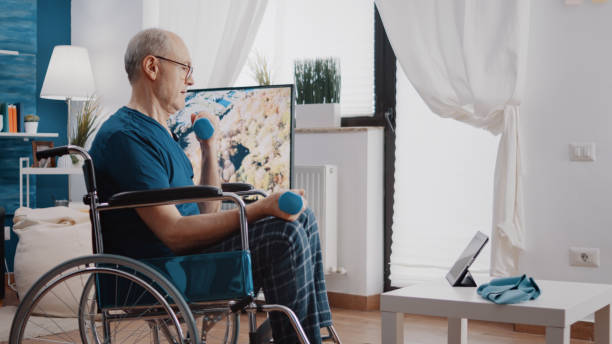Aging is a natural part of life, but with it comes a range of physical and cognitive challenges. For many seniors, mobility issues, chronic pain, and rehabilitation from injuries become part of their daily routine. In recent years, technology has emerged as a key player in supporting older adults through innovative rehabilitation techniques. By integrating digital tools and smart devices, healthcare professionals are transforming the rehabilitation process, helping seniors maintain independence and improve their quality of life.
Contents
- 1 Bridging the Gap Between Technology and Rehabilitation
- 2 Wearable Technology: A Game Changer in Rehabilitation
- 3 Virtual Reality and Gamification: Making Rehabilitation Engaging
- 4 Smart Home Integration: Supporting Independence
- 5 Addressing Accessibility and Digital Literacy
- 6 The Role of Healthcare Professionals
- 7 Looking Ahead: A Future of Empowered Recovery
Bridging the Gap Between Technology and Rehabilitation

One of the most significant challenges in senior healthcare is providing personalized and effective rehabilitation programs. Traditional therapy methods often involve in-person sessions with physiotherapists or occupational therapists, which can be both time-consuming and costly. Technology-assisted rehabilitation offers an alternative that bridges this gap, delivering accessible and personalized care directly to seniors in their own homes.
Remote monitoring systems, for example, allow healthcare providers to track patients’ progress in real-time. Wearable devices measuring heart rate, mobility, and physical activity levels provide accurate data for recovery assessment. Additionally, telemedicine platforms enable therapists to guide seniors through exercises remotely, reducing the need for frequent clinic visits. These advancements not only make rehabilitation more accessible but also encourage consistent participation, ultimately leading to better outcomes.
Wearable Technology: A Game Changer in Rehabilitation
Wearable technology has gained significant traction in senior rehabilitation due to its practicality and efficiency. Devices such as smartwatches, fitness trackers, and motion sensors are equipped with features designed to track physical activity and monitor health metrics. In the context of rehabilitation, these wearables help seniors stay on track with their exercises while providing valuable data to healthcare providers.
For example, smart insoles equipped with pressure sensors can monitor gait and balance, helping detect early signs of mobility issues. Similarly, wearable electrotherapy devices can deliver targeted muscle stimulation, aiding in muscle recovery and pain management. These innovative solutions support ongoing therapy and empower seniors to take control of their rehabilitation journey.
Virtual Reality and Gamification: Making Rehabilitation Engaging
One of the challenges seniors face during rehabilitation is staying motivated. Traditional exercises can become monotonous and repetitive, leading to reduced engagement. Virtual reality (VR) and gamification address this problem by transforming rehabilitation into an interactive and enjoyable experience.
VR-based rehabilitation programs immerse seniors in simulated environments where they can perform therapeutic exercises. Whether it’s a virtual walk in a park or an interactive game that encourages movement, VR engages both the body and mind. This immersive approach not only makes rehabilitation more enjoyable but also improves cognitive function and emotional well-being.
Gamified rehabilitation programs use competition, reward, and progress tracking elements to encourage consistent effort. Seniors can set goals, earn points, and see their improvement over time. This element of fun makes therapy less daunting and fosters a positive attitude toward recovery.
Smart Home Integration: Supporting Independence
Maintaining independence is a priority for many seniors, even when facing rehabilitation. Smart home technologies can play a vital role in supporting this goal. Devices like automated lighting, voice-activated assistants, and mobility aids contribute to a safer and more comfortable living environment.
Smart home systems can be customized in rehabilitation to support mobility training and daily exercises. For instance, voice-controlled exercise prompts can remind seniors to perform specific movements, while automated devices can monitor posture and provide feedback. Integrating these technologies into rehabilitation routines helps seniors practice movements safely and consistently, promoting faster recovery.
Addressing Accessibility and Digital Literacy
Despite the promising potential of technology-assisted rehabilitation, it is crucial to address barriers related to accessibility and digital literacy. Many seniors are unfamiliar with modern devices or may find digital interfaces overwhelming. To ensure the success of technology-driven rehabilitation, healthcare providers must offer user-friendly solutions and adequate training.
Providing hands-on demonstrations and creating step-by-step guides can significantly improve seniors’ comfort with technology. Family members and caregivers can also facilitate this transition by assisting with device setup and usage. By fostering a supportive learning environment, seniors can confidently incorporate technology into their rehabilitation journey.
The Role of Healthcare Professionals
While technology enhances rehabilitation, it does not replace the human touch. Healthcare professionals remain integral to developing personalized treatment plans and offering emotional support. By combining traditional therapeutic methods with modern technology, practitioners can create comprehensive programs that address both physical and emotional aspects of recovery.
Training healthcare workers to integrate technology into their practice is equally important. Professionals must understand how to interpret data from wearable devices and assess the effectiveness of VR-based exercises. As technology evolves, staying updated on new tools will ensure seniors receive the most effective care possible.
Looking Ahead: A Future of Empowered Recovery
Technology-assisted rehabilitation represents a promising future where seniors can regain mobility, improve cognitive function, and enhance their overall quality of life. As innovations continue to emerge, the potential to personalize and streamline rehabilitation will grow. However, to maximize the benefits, it is essential to address challenges related to accessibility, digital literacy, and professional training.
We can create solutions that genuinely empower seniors by fostering collaboration between healthcare providers, technology developers, and caregivers. As rehabilitation becomes more engaging, accessible, and efficient, older adults will gain the confidence to overcome challenges and embrace a more active, fulfilling lifestyle.
In the end, empowering seniors through technology-assisted rehabilitation is not just about advanced devices—it is about fostering independence, dignity, and a renewed sense of purpose.
